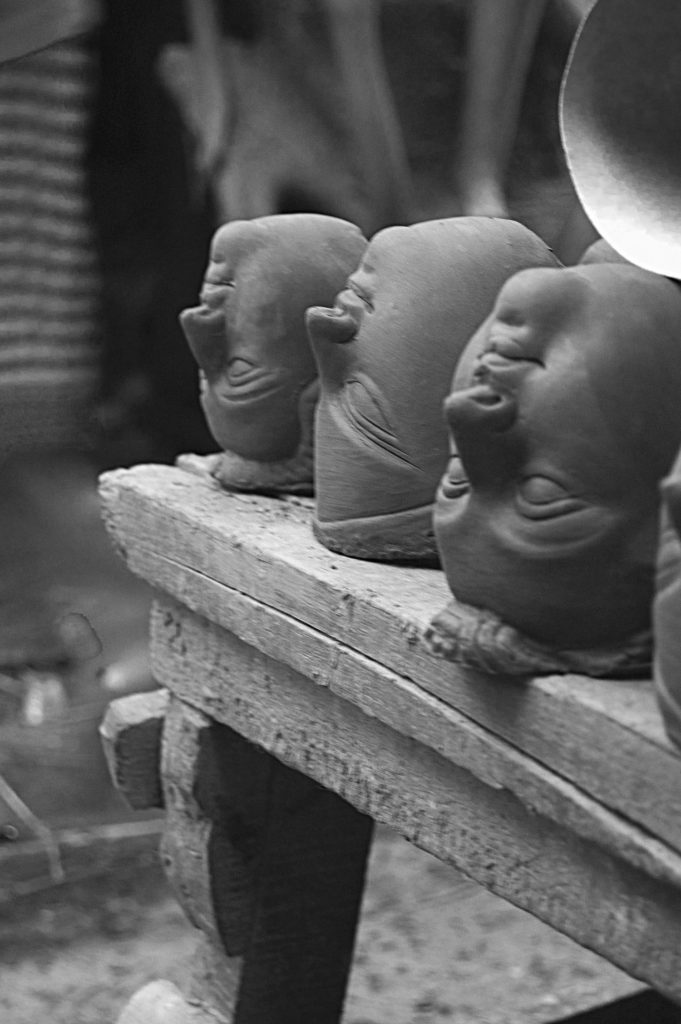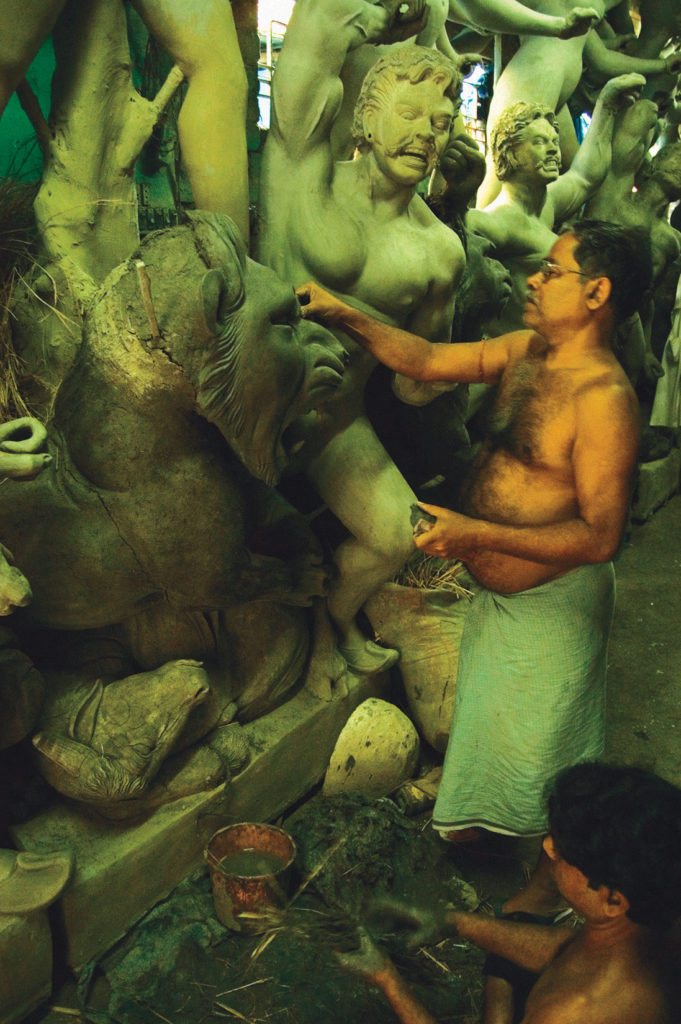By Prasanta Paul
The fragrance of wet clay from the Ganges, dry straw beneath one’s feet, the criss-cross patterns of bamboo spread out within the narrow confines of ramshackle studios; dimly-lit workshops full of idols in various stages of completion, blending seamlessly with the labyrinths of alleys and lanes where the artisans creating goddesses from clay, live their art.
Welcome to ‘Kumartoli’, described as the “cradle of Indian idols” (not to be confused with the eponymous TV show). Kumartoli is more than 300 years old, and found mention in The Bengal Consultations, a journal published in 1707, which describes “Kumartuli’s artisans” who occupied 75 acres of land at Sutanuti (present-day north Kolkata).
There are many claimants to the treasured history of Kumartoli, but for the average Bengali, settled anywhere in the world, Kumartoli is a comforting continuum equally associated with animated adolescence, and the whole span of adulthood, claims historian Runa Sen.
“Durga Puja is not just a religious festival of Bengal, but in itself a religion that is celebrated by all sections of society,” says Sen. “The five-day festival means many things at various stages of your life; each comes with its own colour and flavour.
I distinctly remember holding my parents hand and visiting the various pandals, later I used to hang around with friends and admirers, and now as a mother, I take my son pandal hopping. And all this starts and ends with ‘Kumartoli’, thus completing the cycle of life,” she added, visibly nostalgic.

Kumartoli’s artisans have a rare gift visible during Dussehra: Clay idols of the goddess grace thousands of pandals across the city
Ramesh Chandra Pal, one of the most talented artisans of Kumartuli known for his life like creations of the goddess, could not agree more. “Kuamrtoli symbolises life, where the frame on which we build the goddess comes back to us after the idol is immersed at the end the Durga Puja, thus symbolising a new beginning, where we start to prepare for the next year.”
Today more than anything Durga Puja celebrates the cultural and religious harmony that symbolises Bengal. “Though it is a Hindu religious festival, there are pujas being organised by Muslims and Christians along with Hindus.
There is hardly any religious or social divide, when it comes to the pujas, the entire state comes to usher in the joys of festivity,” says sociologist Tarun Goswami.
Nothing much has changed for the artisans of this fabled place. Faced with financial hardship, these artisans barely manage to make both ends meet. The rising price and declining supply of raw materials, lack of space, working capital and labour problems plague the lives of all idol-makers

Every Bengali has a puja tale-to-tell. Even for Bengali’s born outside India, the word puja becomes so much a part of the household vocabulary, that they come at least once in their lifetime to relive their roots. “I was born and brought up in United States.
Never visited India or Bengal, but always heard of stories about puja from my parents. But now since they are no more, it become imperative on my part to come and see for myself why it meant so much for my parents.
Even at the age of 53, I must admit, I have missed so much of my country of origin. All my life I considered myself a proud American, but today I am proud Bengali, wish I was here before,” said Shalina Bose.
Cut back the romanticism, Kumartoli is the place that provides employment to thousands of people and is the sole source of their livelihood. For the hundreds of shopkeepers, painters, labourers’, suppliers of various raw materials, and of course artisans, it’s a place for sustenance.
“Today, there are around 400 workshops in Kumartuli which provides direct employment to at least 4000 people and indirect employment to another ten thousand,” said Mintu Pal, general secretary of the Kumartuli Potters Association.
Though over the years, the city has undergone tremendous metamorphosis, nothing much has changed for the artisans of this fabled place. Faced with financial hardship, these artisans barely manage to make both ends meet.
The rising price and declining supply of raw materials, lack of space, working capital and labour problems plague the lives of all idol-makers. An average studio in Kumartuli is merely a space where the earthen floor is not even paved.
The walls are a fencing of two wooden boards held together with rope. Tin and matting are some of the materials used in constructing the roof. Electric lighting is minimal, and the artisans squat on the floor to work.
The West Bengal Government had promised a ‘modern’ Kumartuli through ‘The Kumartuli rehabilitation plan’. Spread across an area of five acres, the complex would have housed a sophisticated auditorium that would serve as a studio for the artisans and their assistants.
Promises were made about offering housing to the workers and an art gallery where their work could be preserved and showcased. A miniature model of the projected Rs 260-crore plan was also made.
But like many things in Bengal, it also remained confined to the drawing board and the artisans remain where they were. “Nothing happened,” was the only answer most could offer when asked about the project.
Others complain that chief minister Mamata Banerjee who is so keen to change the image of Bengal, completely lost sight of Bengal’s biggest cultural export the Durga Puja. “Didi (Banerjee) inaugurates hundreds of pujas every year. Even the idols could have at least reminded her of our plight,” said another artisan unwilling to be named.
“The project got delayed because of some administrative procedures. Earlier we identified a piece of land further north of the city to rehabilitate the artisans but there were some litigations pending for that ground,” said an official of the Kolkata Metropolitan Development Authority, the nodal body for implementing the project.
Apart from crumbling infrastructure, artisans complain of lack of social security. “There are Durga Puja organisers who spend lakhs of rupees in organising the Puja, but when it comes to paying for the idols, they are tight fisted,” complains Shibani Pal, one of the few practising women in this male-dominated trade.
“It’s human to look for financial security especially for old age. But for artist like us, there is none and every year we find we are left with less money to sustain ourselves,” she added. Gouranga Pal, another well-known sculptor is unwilling let his grandsons join him in this trade unlike his three sons.
“The future of this trade looks bleak as with every passing year it getting difficult to sustain. There is little help either from the government or from society at large,” said the octogenarian artist.
